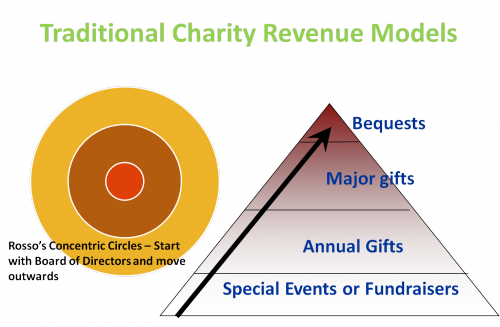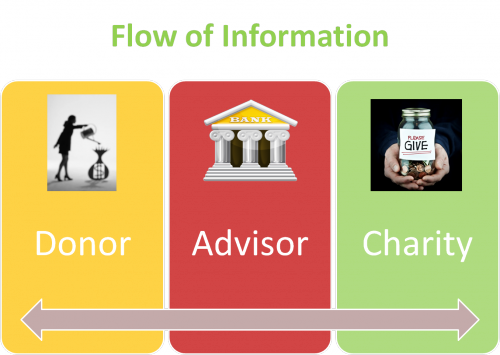Information Flow – What is Influencing Charitable Donations
In a recent presentation to the Banff Community Foundation we discussed how information flows to donors thereby influencing charitable giving and social investing decisions. Traditionally, information about charities came directly from the organizations themselves to the donor. The information was used to move donors up a giving pyramid. The charity’s approach to donor attraction, cultivation and retention, is similar to a for-profit loyalty program sales process. If donors are more engaged (frequency of gifts, frequency of communication, frequency of events) over time they will increase their gift.
The image below shows how charities develop their fundraising strategies and how people are prospected through networks (the inner circle is the board expanding outwards to the general community).

I have said in previous posts, we are facing a social paradigm shift. This shift manifests itself in several ways. In the charitable sector, one of those ways in information transfer. How, where, when and why donors are seeking information about the charities that they currently or intend to support.
In the traditional model, donors would ask charities after the fact, “How did you use my money?” In this new model, donors are asking in advance, “What will you do with my money AND how will you know that you achieved what you set out?”
In order to get the answers to this question, donors are seeking 3rd party evaluations and information. The evaluations come from any number of sources like Charity Intelligence, Place2Give, and the Donner Awards. But this information is also coming from media publications like Advisor’s Edge, Money Sense Magazine, Globe & Mail, McLean’s Magazine and the Chronicle of Philanthropy.
What this means for donors is that they have to be able to distinguish good advice from bad. Charities now have to market themselves, not only to the traditional donor, but also the various advisory services, and those advisory services have to be transparent in how they in-gather data and republish it for donor consumption.

Image: Dexterity Ventures Inc. Copyright 2011
The new charity information landscape looks more like this:

Image: Dexterity Ventures Inc. Copyright 2011
Traditional donation revenue pushing against revenues generated from social impact investment models (typically the expectation of a financial ROI) that in turn is driving the organization’s social mandate. Layered on top of this is inter-generational wealth transfer - $8-10Trillion flowing between one generation and the next by 2050 in Canada. In response to this wealth transfer, individuals and families are opening up private foundations and donor advised funds. This however, does not necessarily translate into more funds directed at front-line services. Foundations are required to disburse 3.5%/year of their fund, yet the investment into the foundation account is the part that is tax receipt-able. What will be interesting over the coming years will be to see how much of these new foundation dollars actually make it into the charitable marketplace; and how policies at the federal level will allow for foundations to do more creative things with their asset base.
For example, a foundation that has a health care mandate, invests a portion of their asset base in a for-profit social enterprise that is working in the medical field. While the investment in the initial stage might be considered high risk, therefore could be seen as a grant, it might also be seed capital, once the business becomes viable the foundation now has an equity stake in the company and can then turn around and reinvest some of those new assets in traditional medical charities.
There are opportunities for donors to Canadian charities to influence the direction that we want to see these policies developed. Let your MP know how you decide which charities to support and where you think government dollars are best invested in managing the flow of charity information to donors. It is more than just having the government review T3010 tax forms.





Comments
Accretive Advisor Group Taking Discussion Lead
For those who are interested in following this discussion. Please join the conversation at the Accretive Advisor LinkedIn group.
Click for more information about Accretive Advisor.
Post new comment